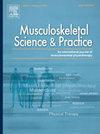Endogenous pain modulation is not different in basketball or volleyball athletes with patellar tendinopathy compared to asymptomatic athletic controls
IF 2.2
3区 医学
Q1 REHABILITATION
引用次数: 0
Abstract
Background
Patellar tendinopathy is highly prevalent in basketball and volleyball athletes. Despite pain being the main symptom reported, underlying mechanisms are unclear.
Objectives
Our primary aim was to compare endogenous pain inhibition using a conditioned pain modulation protocol in basketball and volleyball athletes with patellar tendinopathy to asymptomatic athletic controls. Our secondary aim was to compare endogenous pain facilitation using a temporal summation protocol.
Design
Cross-sectional case-control.
Methods
Twenty-six athletes and 19 asymptomatic controls participated. We calculated the difference in PPT at the patellar tendon over the most painful site (pain site), the ipsilateral tibialis anterior (regional site), and the contralateral elbow lateral epicondyle (remote site), before and after immersion of the hand (ipsilateral to pain site) in painful cold-water. PPT change was used to quantify endogenous pain inhibition. Participants rated pain on a numerical rating scale (NRS; 0 = no pain to 10 = worst pain imaginable) at five, 20, 60 and 120 s during the cold-water immersion task. Change in NRS from five to 20 s quantified temporal summation.
Results
Median symptom duration in our patellar tendinopathy group was 39 (IQR 22.5–55.5) months, and 85% experienced symptoms bilaterally. We did not observe alterations in endogenous pain inhibition at any site, or in temporal summation, in athletes with patellar tendinopathy compared to controls (p > 0.05).
Conclusion
Our findings indicate that altered central nervous system function is not a predominate feature contributing to pain in jumping athletes with patellar tendinopathy. Accordingly, clinicians should view pain as being of a local tissue source if targeting this symptom.
内源性疼痛调节在患有髌骨肌腱病的篮球或排球运动员中与无症状的运动对照组相比没有什么不同
背景:髌骨肌腱病在篮球和排球运动员中非常普遍。尽管疼痛是报告的主要症状,但潜在的机制尚不清楚。目的:我们的主要目的是比较篮球和排球运动员髌骨肌腱病与无症状运动对照中使用条件疼痛调节方案的内源性疼痛抑制。我们的第二个目的是使用时间累积方案比较内源性疼痛促进。DesignCross-sectional病例对照。方法26名运动员和19名无症状对照。我们计算了将手(疼痛部位的同侧)浸泡在疼痛冷水中前后,最痛部位(疼痛部位)、同侧胫骨前肌(局部部位)和对侧肘关节外上髁(远端部位)髌骨肌腱PPT的差异。用PPT变化量化内源性疼痛抑制。参与者用数字评定量表(NRS;0 =无痛到10 =能想象到的最痛),分别在5、20、60和120秒进行冷水浸泡。NRS从5秒到20秒的变化量化的时间总和。结果髌骨肌腱病变组中位症状持续时间为39个月(IQR 22.5-55.5), 85%患者双侧出现症状。与对照组相比,我们没有观察到髌骨肌腱病变运动员在任何部位或时间上的内源性疼痛抑制发生变化(p >;0.05)。结论中枢神经系统功能的改变并不是导致跳远运动员髌骨肌腱病变疼痛的主要原因。因此,如果针对这种症状,临床医生应该将疼痛视为局部组织源。
本文章由计算机程序翻译,如有差异,请以英文原文为准。
求助全文
约1分钟内获得全文
求助全文
来源期刊

Musculoskeletal Science and Practice
Health Professions-Physical Therapy, Sports Therapy and Rehabilitation
CiteScore
4.10
自引率
8.70%
发文量
152
审稿时长
48 days
期刊介绍:
Musculoskeletal Science & Practice, international journal of musculoskeletal physiotherapy, is a peer-reviewed international journal (previously Manual Therapy), publishing high quality original research, review and Masterclass articles that contribute to improving the clinical understanding of appropriate care processes for musculoskeletal disorders. The journal publishes articles that influence or add to the body of evidence on diagnostic and therapeutic processes, patient centered care, guidelines for musculoskeletal therapeutics and theoretical models that support developments in assessment, diagnosis, clinical reasoning and interventions.
 求助内容:
求助内容: 应助结果提醒方式:
应助结果提醒方式:


